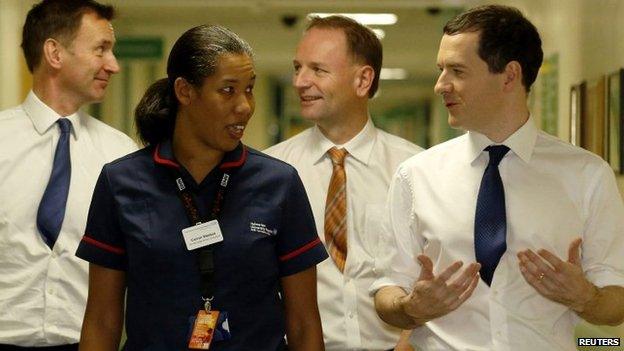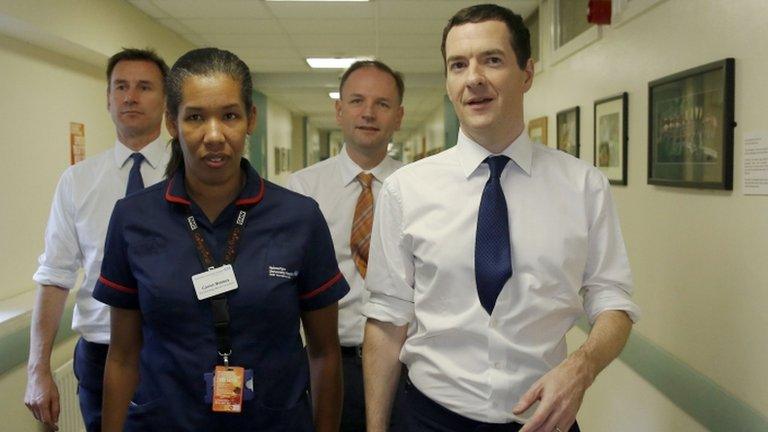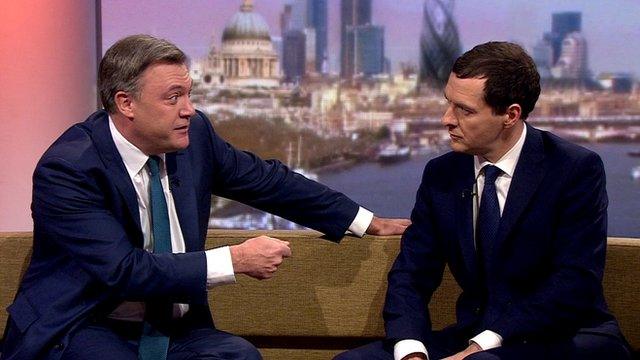NHS funding: How do the sums add up?
- Published
- comments

£2bn more for the NHS - £1.3bn of new money for health - £1bn boost to NHS England finances - £1.2bn for GPs. Which is correct?
Actually... all of them are. Confused? You would have every right to be.
As details of Chancellor George Osborne's health spending package emerged a few hours after the newspaper headlines, the old cliche "the devil is in the detail" seemed rather apt.
It is true that different elements of the new health package add up to £2bn for the financial year 2015/16, beginning in April a month before the election.
This is the government's response to increasing levels of concern that the NHS in England will have an unbridgeable financial gap and that staffing levels and quality of care would suffer without an urgent injection of cash.
Frontline services
So how did the chancellor get to that £2bn?
The starting point is £1bn of money cobbled together from underspending by other Whitehall departments under Westminster control.
That pot of cash will be reallocated to health.
It's a definite win for the NHS in the sense of receiving money which wouldn't otherwise have been there.
Under the Barnett formula that £1bn for England generates another £300m for Scotland, Wales and Northern Ireland to spend on health if they so wish, hence that £1.3bn figure.

Then there's another £700m to be allocated to NHS England for "frontline services" - again, money the service wouldn't until today have anticipated for the financial year beginning in April.
Confusingly, perhaps, this chunk of money comes from the existing Department of Health budget. Health money going to NHS shock...
What's the story?
This is money which would otherwise have been held in the safes and piggy banks at the Department of Health. Now it will available from day one of the financial year for hospitals, community health and other "frontline" areas of the NHS.
The final piece of the jigsaw is the genuinely new money for GPs to invest in their facilities and develop a wider range of care and treatment outside hospitals.
Paid for by bank fines following the foreign exchange rigging scandal, a new fund will make £300m a year available (£250m in England), totalling £1.2bn over four years.
This is the sort of investment which the head of NHS England Simon Stevens had in mind when he called for new community health provision to reduce demands on hospitals and cut costs.
'Kickstart' modernisation
The relationship between Mr Stevens and the chancellor is intriguing.
It appears there were three meetings over the last week between the two men. I am told the Treasury was impressed with the NHS chief's five-year view, published in October.
In this document Mr Stevens stated that two thirds of the financial gap facing the NHS in England in 2020 could be closed by more efficient use of resources and more effective care in local communities. That left an £8bn hole to close, a task which seemed to Mr Osborne to be realistic over the lifetime of the next parliament.
In essence, Mr Stevens and his colleagues have promised to take enough of the strain of the financial challenges facing the NHS to have won over the most hard-nosed Treasury mandarins.
He has promised reform and efficiency savings but in return has asked for cash up front to sort out next year's problems and in his own words "kick-start" NHS modernisation.
Crucially, he has been given more cash even at a time of intense restraint around Whitehall.
- Published30 November 2014

- Published30 November 2014

- Published27 November 2014